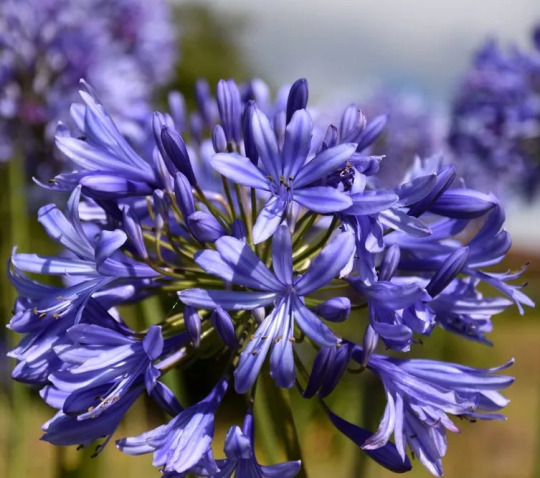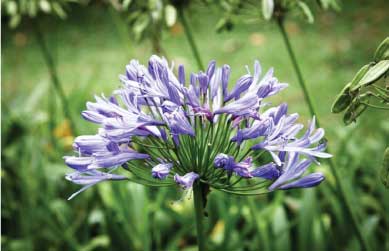Agapanthus, also known as the “Lily of the Nile” or “African Lily,” is a stunning perennial flower that adds a touch of elegance to any garden. With its striking blue or white blossoms and lush, strap-like foliage, agapanthus is a popular choice among gardeners for borders, containers, and mass plantings. This comprehensive guide will walk you through everything you need to know about growing agapanthus, from planting and caring for them to solving common problems. Let’s dive into the world of agapanthus and discover how to grow Agapanthus in your garden.
Understanding Agapanthus: A Brief Overview
Agapanthus belongs to the family Amaryllidaceae and is native to South Africa. They are known for their tall, slender stems topped with clusters of trumpet-shaped flowers. The two main types of agapanthus are evergreen and deciduous. Evergreen varieties retain their leaves year-round and thrive in milder climates, while deciduous varieties lose their foliage in winter and are more tolerant of colder temperatures.
Agapanthus blooms from mid-summer to early autumn, with flowers that range in color from deep blue and violet to pale blue and white. The plant’s foliage is clump-forming and adds a lush, green backdrop to its dramatic blooms.
Choosing the Right Location for Agapanthus
Agapanthus thrives in a sunny location that receives at least six hours of direct sunlight per day. While they can tolerate partial shade, full sun promotes more abundant flowering. A spot with morning sun and afternoon shade is ideal in hotter climates to protect the plants from scorching.
Additionally, the soil should be well-draining. Agapanthus prefers soil that is slightly acidic to neutral (pH 6.0-7.5) and enriched with organic matter. Heavy, clay soils can cause waterlogging, leading to root rot, so it’s essential to improve drainage by adding sand or grit if necessary.
Planting Agapanthus: Step-by-Step Guide
- Timing: The best time to plant agapanthus is in spring or early summer when the soil is warm. In mild climates, autumn planting is also possible.
- Prepare the Soil: Loosen the soil to a depth of 12-15 inches and work in compost or well-rotted manure to improve fertility and drainage.
- Spacing: Space agapanthus plants or rhizomes about 12-18 inches apart to allow for proper air circulation and growth. For a more dramatic effect, plant them in clusters of three or five.
- Planting Depth: Dig a hole twice the width of the root ball or rhizome and place the plant so that the crown is at or just above soil level. For rhizomes, position them with the roots facing downward and cover them with 1-2 inches of soil.
- Watering: Water thoroughly after planting to help settle the soil around the roots. Keep the soil consistently moist until the plants are established.

Caring for Agapanthus: Tips for Healthy Growth
- Watering: Agapanthus requires regular watering, especially during dry spells. Water deeply once or twice a week, depending on the climate, ensuring the soil remains consistently moist but not waterlogged. In the first year, frequent watering helps establish a strong root system. Afterward, water less frequently but deeply.
- Fertilizing: Apply a balanced, slow-release fertilizer in early spring to promote growth. During the growing season, feed monthly with a liquid fertilizer high in potassium (like tomato feed) to encourage flowering. Avoid over-fertilizing, as this can lead to lush foliage but fewer blooms.
- Mulching: Apply a layer of organic mulch, such as bark chips or compost, around the base of the plant to conserve moisture, suppress weeds, and protect the roots from extreme temperatures.
- Pruning and Deadheading: Remove spent flowers to encourage continuous blooming and prevent self-seeding. Cut back flower stalks to the base once they have finished blooming. Trim dead or damaged leaves to maintain a neat appearance.
Winter Care for Agapanthus
Agapanthus is hardy in USDA zones 8-11, but in colder regions, they require protection from frost.
- Evergreen Varieties: In milder climates, evergreen agapanthus can stay in the ground year-round. Apply a thick layer of mulch around the base to insulate the roots.
- Deciduous Varieties: In colder climates, deciduous varieties benefit from additional winter protection. Cover the crowns with straw or horticultural fleece, or dig up the plants and overwinter them in pots indoors.
Growing Agapanthus in Containers
Agapanthus is an excellent choice for container gardening, particularly in regions with cold winters where plants need to be brought indoors. Here’s how to grow agapanthus in pots:
- Select the Right Container: Choose a large pot with drainage holes to accommodate the plant’s root system. Agapanthus prefers slightly cramped conditions, which can promote more flowering. A container that is 12-18 inches in diameter is ideal for a single plant.
- Use the Right Soil: Use a well-draining potting mix, ideally one designed for perennials or a mix of garden soil, sand, and compost.
- Watering and Feeding: Container-grown agapanthus needs more frequent watering, especially during hot, dry weather. Water thoroughly when the top inch of soil feels dry. Fertilize monthly with a balanced liquid fertilizer during the growing season.
- Overwintering: In colder climates, bring pots indoors before the first frost. Keep them in a cool, frost-free place, such as a greenhouse or basement, and water sparingly during winter dormancy.
Common Pests and Diseases Affecting Agapanthus
- Snails and Slugs: These pests are attracted to the fleshy leaves and can cause significant damage. Use organic slug pellets or set up traps to keep them at bay.
- Root Rot: Caused by overwatering or poor drainage, root rot can be fatal to agapanthus. Ensure the soil is well-draining and avoid waterlogging.
- Red Spider Mites and Aphids: These pests may occasionally attack agapanthus, especially in hot, dry conditions. Treat infestations with insecticidal soap or neem oil.
Propagation of Agapanthus
Agapanthus can be propagated through division or seed.
- Division: The easiest method is to divide clumps in early spring or late autumn. Dig up the plant, separate the clumps with a sharp knife or spade, and replant them at the same depth.
- Seed: Collect seeds from mature seed heads in autumn. Sow them in pots filled with a seed-starting mix and keep them in a warm, bright location. Germination can take several weeks to months, and plants grown from seeds may take 2-3 years to flower.
Popular Agapanthus Varieties to Grow
- Agapanthus ‘Blue Storm’: A compact, vigorous variety with deep blue flowers. Perfect for borders or containers.
- Agapanthus africanus: Known for its large, blue or white flower clusters and evergreen foliage. Ideal for warmer climates.
- Agapanthus ‘Snow Storm’: Features stunning white blooms and dark green leaves. Suitable for both gardens and pots.
- Agapanthus ‘Peter Pan’: A dwarf variety with light blue flowers, great for small gardens or container planting.
Landscaping with Agapanthus
Agapanthus is versatile and can be used in various garden settings:
- Borders and Edges: Plant agapanthus along borders to create a striking edge with their tall stems and bold colors.
- Mass Planting: For dramatic impact, plant in large groups or drifts. Combine with other perennials like daylilies, ornamental grasses, or lavender for a mixed border.
- Containers and Patios: Grow agapanthus in pots on patios or balconies to create an elegant display. Pair them with trailing plants like ivy or bacopa for added interest.
Conclusion
Growing agapanthus can be a rewarding experience for any gardener, offering beautiful blooms and low-maintenance care. By selecting the right location, providing proper care, and protecting them from pests and diseases, you can enjoy these stunning flowers year after year. Whether planted in the ground or containers, agapanthus brings a touch of elegance and color to any garden.
Are you ready to start growing agapanthus? With this guide, you have all the knowledge needed to cultivate these eye-catching plants successfully. Happy gardening!
